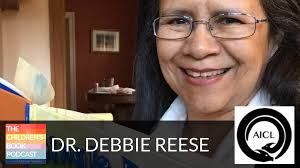
The Indian Affairs Committee of Salem Quarter, Society of Friends, holds a concerned for biases, stereotypes, and myths, portrayed in predominant media and views held by non-indigenous peoples about indigenous peoples. We recently participated in a webinar with guest Dr. Debbie Reese, Founder of American Indians in Children’s Literature, hosted by EmbraceRace.
Media has long portrayed Native peoples in stereotypical imagery – feathered headdresses, fringed leather clothing, sitting around fires, telling legends, living in tipis, hunting buffalo, and attacking pioneers. When choosing books by and about American Indians, Dr. Reese suggests the following four tips:
1) Choose books written or illustrated by native people, #OwnVoices books, in which “the protagonist and the author share a marginalized identity,” help us to push against the idea that Native peoples no longer exist. Selecting a book by a Native writer allows you to use the powerful verb IS: “Let’s read Jingle Dancer! It is by Cynthia Leitich Smith. She is a citizen of the Muscogee Nation. Her main character, Jenna, is Muscogee, too.” Most books by nonNative authors – like Island of the Blue Dolphins and Julie of the Wolves – misrepresent Native people and relegate us to the past.
2) Choose books that include information about the nationhood status of native peoples. It is crucial that everybody become familiar with the fact that Native nations pre-date the United States and its nationhood status. Our status as sovereign nations is based on treaty and trust agreements made between early European nations, and later the US government, and Native nations. Sovereign nationhood is the defining feature of Native identity. Native individuals are citizens of sovereign nations, all of whom have ways of determining who their citizens are.
3) Choose books set in the present day. Most books about Native people are set in the past, but we are very much part of the present day. Some of us live on reservations, but some of us are in suburban and urban areas. You can see that when you open Jingle Dancer. Jenna wears the same kind of clothes any little girl wears, and lives in a modern-day house in a suburb with tree-lined streets. Other Native people live there, too, and there is a powwow coming up. Jenna will be doing the Jingle Dance at that powwow.
4) Choose books that are tribally specific. Just as Mexico, Canada, and the United States have significantly different histories, cultures, and contemporary dynamics, so do the 500+ Native tribal nations that have state-to-state relationships with the United States government. Native peoples are different in many ways, including the languages they speak. For example, a common error is crossword puzzles that ask for “the Native American word for baby,” as if we all speak the same language. The puzzle maker thought Native people all use “papoose,” but that is not the case.
When asked about the use of, “…American Indian? Or, Native American?” Dr. Reese replied, “There is no agreement among Native peoples. Both are used. It is best to be specific. Instead of ‘Debbie Reese, a Native American,’ say ‘Debbie Reese, a Nambe Pueblo Indian woman.’” Dr. Reese also addressed non-native people’s confusion of native peoples as a “race” rather than nationhood. For example, when considering if there is a way to be ½ Pueblo, a rhetorical question might sound like, “Is there a way to be ½ American? No, it’s citizenship.” Tribal Nations’ citizens are determined by their relations and history, not based on looks; there is a range of appearances among American Indians.
We also heard of equally corresponding inappropriate pre/ post reading activities by non-natives – creating Dream Catchers, Totem Poles, and unauthentic creation stories – that exemplify sacred pieces of specific cultures, not to be appropriated. Such activities are misappropriations of culture, as would be an activity to create a new Bible story. Non-native peoples are guided to ponder a) what we are doing, b) who is represented, and c) what are we trying to do? Let’s consider a reenactment; it is not acceptable to “dress-up” like a Native American. Why? Because it perpetuates harms, it is dismissive to indigenous peoples, and this “push back” projects burdens that are subsequently carried by an indigenous person and/ or community.
Dr. Reese also recommends the following resources:
1) Lessons From Turtle Island: Native Curriculum in Early Childhood Classrooms by Guy W. Jones and Sally Moomaw;
2) AN INDIGENOUS PEOPLES’ HISTORY OF THE UNITED STATES – FOR YOUNG PEOPLE adapted by Jean Mendoza and Debbie Reese, from the original work of Roxanne Dunbar-Ortiz; and
3) Dr. Reese’s website, American Indians In Children’s Literature, http://www.americanindiansinchildrensliterature.net.
Friends find that Dr. Debbie Reese’s perspectives rest easy on our hearts and align with what we hear from our friends of the Nanticoke Lenni-Lenape Tribal Nation.